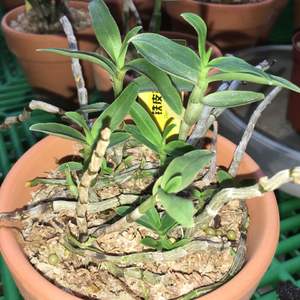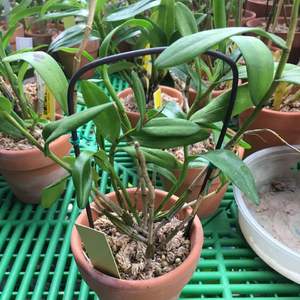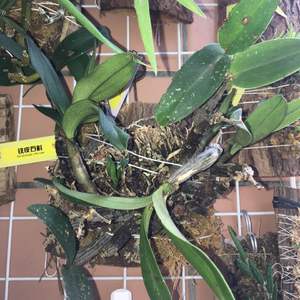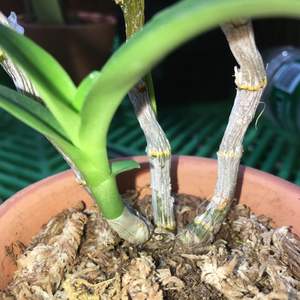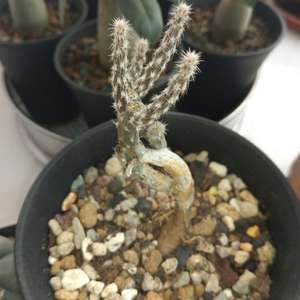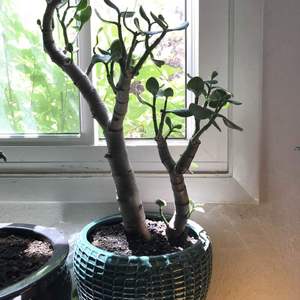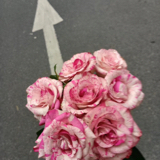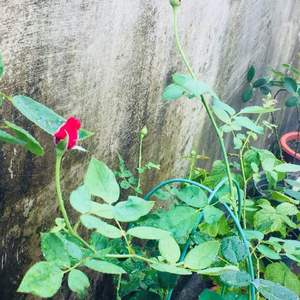文章
Miss Chen
2018年07月05日

A ripe rind is one sign a butternut squash (Cucurbita moschata) is ready to pick, and there are other signs. An annual winter squash vine, butternut squash grows 3/4 to 1 1/2 feet tall with a vine 10 to 15 feet long. Creamy-white to orange-yellow flowers appear in late spring and orange-fleshed fruits develop, which ripen in fall. Changes in the vine and changes in the color and texture of the fruit are some signs to look for that tell you butternut squash is ready for harvesting.
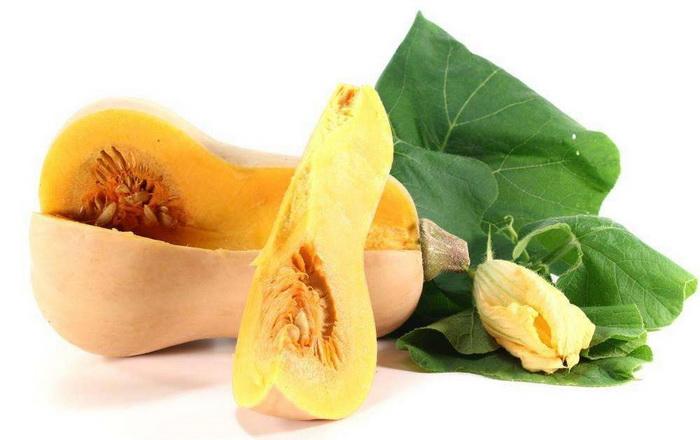
Days From Sowing
Providing severe weather conditions such as drought or prolonged cold temperatures don't occur, butternut squash fruits ripen a predictable number of days after sowing. In regular growing conditions, it takes 80 to 100 days after the seed was sown.
Drought stresses plants, and may speed up ripening. However, cold weather slows down butternut squash growth, and then fruit may ripen later than expected.
Vine Condition
When butternut squash fruits are ready for picking, the vine has done its job. It stops growing and begins to die back. If your butternut squash vine stops producing new shoots and leaves, and the existing leaves begin to yellow and wilt, the fruit is probably nearly ripe.
Skin Appearance
Butternut squash skin is light whitish-green, smooth and shiny while the fruit is growing. As they ripen, the fruits turn deep tan and become dull and dry.
Skin Texture
A change in skin texture is another sign of ripeness in butternut squash. Slightly soft when the fruit is growing, butternut squash skin becomes very tough when the fruit is ripe.
Harvest Time
When butternut squash fruit are ready to harvest, cut the stems with pruning shears or a sharp knife.

Cut the squash stems 1 inch from the fruit, and put them in a cool, dark, dry place. Don't allow the fruit to touch each other. Store the squash at 50 degrees Fahrenheit and 50 to 75 percent humidity and it will keep for two to three months. Check the fruit every one or two weeks, and remove and discard any that look diseased or have begun to decay.

Days From Sowing
Providing severe weather conditions such as drought or prolonged cold temperatures don't occur, butternut squash fruits ripen a predictable number of days after sowing. In regular growing conditions, it takes 80 to 100 days after the seed was sown.
Drought stresses plants, and may speed up ripening. However, cold weather slows down butternut squash growth, and then fruit may ripen later than expected.
Vine Condition
When butternut squash fruits are ready for picking, the vine has done its job. It stops growing and begins to die back. If your butternut squash vine stops producing new shoots and leaves, and the existing leaves begin to yellow and wilt, the fruit is probably nearly ripe.
Skin Appearance
Butternut squash skin is light whitish-green, smooth and shiny while the fruit is growing. As they ripen, the fruits turn deep tan and become dull and dry.
Skin Texture
A change in skin texture is another sign of ripeness in butternut squash. Slightly soft when the fruit is growing, butternut squash skin becomes very tough when the fruit is ripe.
Harvest Time
When butternut squash fruit are ready to harvest, cut the stems with pruning shears or a sharp knife.

Cut the squash stems 1 inch from the fruit, and put them in a cool, dark, dry place. Don't allow the fruit to touch each other. Store the squash at 50 degrees Fahrenheit and 50 to 75 percent humidity and it will keep for two to three months. Check the fruit every one or two weeks, and remove and discard any that look diseased or have begun to decay.
0
0
文章
Miss Chen
2018年07月03日

Description: This perennial wildflower is about 1-2' tall. It is unbranched, except near the apex, where the flowerheads occur. The central stem is pale green and more or less covered with white cobwebby hairs. The alternate leaves are up to 6" long and 1" across, becoming slightly smaller as they ascend the stems. Each fern-like leaf is pale to medium green, elliptic in outline, and widest in the middle – however, its structure is either simple-pinnate or double-pinnate and its overlapping leaflets are either simple-pinnate or pinnatifid. The leaves and sometimes their leaflets (when they are simple-pinnate) are upward-angled along their rachises (central stalks), while pinnatifid leaflets and subleaflets are either curled, crinkled, or flat. Like the stems, the leaves and their subdivisions often have fine cobwebby hairs. The leaves are sessile.
The upper stems produce flat-headed panicles (compound corymbs) of small flowerheads. Each flowerhead is about ¼" across, consisting of 5 ray florets (their petaloid rays are white, rarely rose or other pastel colors) and a similar number of disk florets that have cream or pale yellow corollas. The petaloid rays are often slightly notched at their tips. The floral bracts (phyllaries) are pale green and lanceolate-oblong; they often have cobwebby hairs. All parts of this plant exude a distinctive aroma that is somewhat soapy and astringent. The blooming period occurs from early to mid-summer and lasts about a month. Each floret is replaced by an achene that is oblong and somewhat flattened; it lacks a tuft of hairs. The root system produces abundant rhizomes, often forming clonal colonies of plants.

Cultivation: The preference is full or partial sun, mesic to dry conditions, and a somewhat heavy clay-loam soil.
Range & Habitat: Yarrow is a common plant that has naturalized in all counties of Illinois (see Distribution Map). The variety of Yarrow that occurs in Illinois is probably native to Eurasia, although there is a variety of this plant that is native to western North America. This latter variety tends to be smaller in size and its foliage is more heavily covered with woolly hairs. Habitats include mesic to dry prairies, pastures, fallow fields, grassy waste areas, and edges of paths, yards, or hedges. Disturbed areas are preferred; Yarrow persists in native habitats (e.g., prairies) to a limited extent. Yarrow is often cultivated in flower and herbal gardens, from where it occasionally escapes.

Faunal Associations: The nectar of the flowers attracts many kinds of insects, especially flies and wasps. Among the flies are such visitors as bee flies, Syrphid flies (including drone flies), thick-headed flies, Tachinid flies, flesh flies, Anthomyiid flies, and others. Halictid and other short-tongued bees occasionally visitor the flowers, where they suck nectar and collect pollen. Many species of grasshoppers feed on Yarrow (see Grasshopper Table), as do several aphids, a seed bug, a flower thrips, leaf beetles, and caterpillars of some moths (see Insect Table). Sometimes Mordella spp. (Tumbling Flower Beetles) are found on the flowerheads. Because the foliage of Yarrow has a bitter and biting taste, it is rarely consumed by most mammalian herbivores. However, sheep will eat it when the opportunity arises.

Photographic Location: Judge Webber Park and Meadowbrook Park in Urbana, Illinois.
Comments: Among members of the Aster family, the fern-like foliage of Yarrow is rather unusual and it has a distinctive odor. Other members of the Aster family with this kind of foliage include Anthemis spp. (Mayweed), Matricaria spp. (Chamomile), and Tanacetum vulgare (Tansy). Unlike Yarrow, species of Mayweed and Chamomile produce daisy-like flowerheads with long petaloid rays. Tansy is a larger plant with medium to dark green foliage. While its flowerheads have a similar size and structure as compared to those of Yarrow, they are bright yellow and their petaloid rays are even smaller in size or absent.
The upper stems produce flat-headed panicles (compound corymbs) of small flowerheads. Each flowerhead is about ¼" across, consisting of 5 ray florets (their petaloid rays are white, rarely rose or other pastel colors) and a similar number of disk florets that have cream or pale yellow corollas. The petaloid rays are often slightly notched at their tips. The floral bracts (phyllaries) are pale green and lanceolate-oblong; they often have cobwebby hairs. All parts of this plant exude a distinctive aroma that is somewhat soapy and astringent. The blooming period occurs from early to mid-summer and lasts about a month. Each floret is replaced by an achene that is oblong and somewhat flattened; it lacks a tuft of hairs. The root system produces abundant rhizomes, often forming clonal colonies of plants.

Cultivation: The preference is full or partial sun, mesic to dry conditions, and a somewhat heavy clay-loam soil.
Range & Habitat: Yarrow is a common plant that has naturalized in all counties of Illinois (see Distribution Map). The variety of Yarrow that occurs in Illinois is probably native to Eurasia, although there is a variety of this plant that is native to western North America. This latter variety tends to be smaller in size and its foliage is more heavily covered with woolly hairs. Habitats include mesic to dry prairies, pastures, fallow fields, grassy waste areas, and edges of paths, yards, or hedges. Disturbed areas are preferred; Yarrow persists in native habitats (e.g., prairies) to a limited extent. Yarrow is often cultivated in flower and herbal gardens, from where it occasionally escapes.

Faunal Associations: The nectar of the flowers attracts many kinds of insects, especially flies and wasps. Among the flies are such visitors as bee flies, Syrphid flies (including drone flies), thick-headed flies, Tachinid flies, flesh flies, Anthomyiid flies, and others. Halictid and other short-tongued bees occasionally visitor the flowers, where they suck nectar and collect pollen. Many species of grasshoppers feed on Yarrow (see Grasshopper Table), as do several aphids, a seed bug, a flower thrips, leaf beetles, and caterpillars of some moths (see Insect Table). Sometimes Mordella spp. (Tumbling Flower Beetles) are found on the flowerheads. Because the foliage of Yarrow has a bitter and biting taste, it is rarely consumed by most mammalian herbivores. However, sheep will eat it when the opportunity arises.

Photographic Location: Judge Webber Park and Meadowbrook Park in Urbana, Illinois.
Comments: Among members of the Aster family, the fern-like foliage of Yarrow is rather unusual and it has a distinctive odor. Other members of the Aster family with this kind of foliage include Anthemis spp. (Mayweed), Matricaria spp. (Chamomile), and Tanacetum vulgare (Tansy). Unlike Yarrow, species of Mayweed and Chamomile produce daisy-like flowerheads with long petaloid rays. Tansy is a larger plant with medium to dark green foliage. While its flowerheads have a similar size and structure as compared to those of Yarrow, they are bright yellow and their petaloid rays are even smaller in size or absent.
0
0
文章
Miss Chen
2018年07月03日

Description: This annual plant is ½–2' tall, and usually unbranched. The central stem has lines of fine white hairs, or is glabrous. The alternate leaves are up to 3½" long and 1" across, with long narrow petioles that are slightly hairy. They are lanceolate or ovate, with bluntly serrated margins and conspicuous pinnate venation. There is a tendency for the leaves to congregate together near the top of the central stem, or any side stems that may be present. Where the petiole of each leaf meets the stem, there is a conspicuous bract that wraps around the inflorescence consisting of a green cyathium. This bract is slightly ciliate along the edges, and has 5-9 lobes. The cyathium contains tiny staminate and pistillate flowers without sepals and petals. The staminate flower is covered with yellow pollen, while the pistillate flower produces a 3-lobed spheroid fruit that is typical of the spurges. Each fruit contains three seeds. The blooming period occurs from about mid-summer until frost during the fall, and lasts one or more months. There is no floral scent. The root system consists of a central taproot.
Cultivation: The preference is light shade to full sun, and moist to slightly dry conditions. This plant often grows in fertile, loamy soil, but can tolerate gravelly or clay soil as well. This plant is easy and undemanding, and may volunteer spontaneously in a wildflower garden or ecological restoration. However, it is rather common and weedy.
Range & Habitat: The native Rhomboid Mercury occurs in every county of Illinois, and it is quite common (see Distribution Map). This is a rather inconspicuous plant that is easily overlooked because of the lack of showy flowers. Habitats include disturbed areas of moist prairies, limestone glades, openings or lightly shaded areas of floodplain forests, thickets, seeps, stream banks, ditches, fields, fence rows, roadsides, areas along railroads, vacant lots, poorly maintained lawns and gardens, and waste areas. This plant prefers moist disturbed areas.
Faunal Associations: Like other members of the Spurge family that occur in Illinois, the seeds are attractive to such birds as the Mourning Dove and Greater Prairie Chicken; they may also be attractive to the Bobwhite, Horned Lark, and Wild Turkey. The herbaceous Acalypha spp. in Illinois lack the poisonous white latex of other members in the Spurge family, and their foliage is probably less toxic as a result. Deer are known to browse on Acalypha spp. occasionally, and it is possible that other mammalian herbivores do this as well. There have been reports of cattle being poisoned by these plants, possibly because of accumulation of nitrates in the foliage. It is unclear to me if the flowers of Acalypha spp. are wind- or insect-pollinated, although I suspect the former.

Photographic Location: The photographs were taken in a front yard along a roadside near Urbana, Illinois.
Comments: There are several Acalypha spp. in Illinois; the number of seeds per fruit can range from 1 to 3 (usually the latter), depending on the species. The species described here, Acalypha rhomboidea, is very similar to Acalypha virginica, except that the latter has 9-15 lobes in the bract that surrounds the inflorescence at the base of the petiole. Some authorities consider the former species to be merely a variety of the latter. The foliage of Acalypha spp. often becomes purplish tan during the fall, which has inspired the common name, 'Copperleaf.' This common name is often used in the agricultural industry.
Cultivation: The preference is light shade to full sun, and moist to slightly dry conditions. This plant often grows in fertile, loamy soil, but can tolerate gravelly or clay soil as well. This plant is easy and undemanding, and may volunteer spontaneously in a wildflower garden or ecological restoration. However, it is rather common and weedy.
Range & Habitat: The native Rhomboid Mercury occurs in every county of Illinois, and it is quite common (see Distribution Map). This is a rather inconspicuous plant that is easily overlooked because of the lack of showy flowers. Habitats include disturbed areas of moist prairies, limestone glades, openings or lightly shaded areas of floodplain forests, thickets, seeps, stream banks, ditches, fields, fence rows, roadsides, areas along railroads, vacant lots, poorly maintained lawns and gardens, and waste areas. This plant prefers moist disturbed areas.
Faunal Associations: Like other members of the Spurge family that occur in Illinois, the seeds are attractive to such birds as the Mourning Dove and Greater Prairie Chicken; they may also be attractive to the Bobwhite, Horned Lark, and Wild Turkey. The herbaceous Acalypha spp. in Illinois lack the poisonous white latex of other members in the Spurge family, and their foliage is probably less toxic as a result. Deer are known to browse on Acalypha spp. occasionally, and it is possible that other mammalian herbivores do this as well. There have been reports of cattle being poisoned by these plants, possibly because of accumulation of nitrates in the foliage. It is unclear to me if the flowers of Acalypha spp. are wind- or insect-pollinated, although I suspect the former.

Photographic Location: The photographs were taken in a front yard along a roadside near Urbana, Illinois.
Comments: There are several Acalypha spp. in Illinois; the number of seeds per fruit can range from 1 to 3 (usually the latter), depending on the species. The species described here, Acalypha rhomboidea, is very similar to Acalypha virginica, except that the latter has 9-15 lobes in the bract that surrounds the inflorescence at the base of the petiole. Some authorities consider the former species to be merely a variety of the latter. The foliage of Acalypha spp. often becomes purplish tan during the fall, which has inspired the common name, 'Copperleaf.' This common name is often used in the agricultural industry.
0
0
文章
Miss Chen
2018年07月03日

Description: This plant is a summer annual about 1–2½' tall, branching occasionally. The stems are terete or somewhat angular and they have spreading white hairs. The alternate leaves are up to 4" long and 2½" across. They are rather thin-textured and have raised veins on their undersides. The leaves are medium green, cordate or broadly ovate, and serrated along their margins. The long slender petioles often have spreading hairs like the stems. Hornbeam Mercury is monoecious with separate male and female flowers on the same plant. The male (staminate) flowers develop from the axils of the leaves in non-terminal spikes about ½–2" long. These cylindrical spikes are densely crowded with small flowers. Each male flower is about 1/8" (3 mm.) across, consisting of 4 sepals that are green or translucent white, several stamens that are white, and no petals. The spikes of female (pistillate) flowers terminate the upper stems; they are usually located above the male flowers. The pistillate spikes are also densely crowded with small flowers, but their appearance is less smooth and cylindrical than the staminate spikes because of the long styles and floral bracts. Each female flower is about ¼" across, consisting of several long branching styles that are white, a green ovary that is quite spiny in appearance, and no petals. At the base of each female flower, there is a surrounding floral bract with several narrow lobes. The blooming period occurs from mid-summer to early fall and lasts about 1-2 months. The flowers are cross-pollinated by the wind. Afterwards, the female flowers are replaced by 3-valved seed capsules; each valve of a capsule contains a single seed. The seeds are ovoid in shape, broader and rounder at one end than the other, and pitted or wrinkled across the surface. The root system consists of a taproot. This plant spreads by reseeding itself, and occasionally forms colonies.

Cultivation: This plant is typically found in full or partial sun, moist to mesic conditions, and a fertile loamy soil. It also occurs in clay-loam and stony soil. At locations that are too hot and dry, the foliage often wilts.
Range & Habitat: The native Hornbeam Mercury occurs occasionally in the southern half of Illinois (see Distribution Map). Habitats include thickets, riverbanks, lower slopes of bluffs, cropland, fallow fields, gardens, areas along buildings, and roadsides. This native species prefers disturbed areas and it is a minor pest of cropland in the southern half of the state.
Faunal Associations: The flowers don't attract many insects because they are wind-pollinated. Two flea beetles, Hornaltica bicolorata and Margaridisa atriventris, feed on Acalypha spp. The seeds are occasionally eaten by the Mourning Dove and probably other granivorous birds. Deer browse on the foliage of these plants, and possibly other mammalian herbivores do this as well. The foliage may be mildly toxic to cattle because of excess nitrate accumulation. Unlike many other members of the Spurge family, the native Acalypha spp. lack a toxic white latex in their foliage.
Photographic Location: A few plants were growing along the foundation of the webmaster's apartment complex in Urbana, Illinois.
Comments: Hornbeam Mercury is a nondescript plant that is easily overlooked. Its leaves are supposed to resemble the leaves of hornbeam trees (e.g., Ostrya spp.), hence the common name. Another common name is Rough-Podded Copperleaf, which refers to the spiny-looking seed capsules and the tendency of the foliage to turn reddish brown during the fall. Hornbeam Mercury differs from other native Acalypha spp. by its monoecious flowers (separate spikes of male and female flowers) and its broad serrated leaves that are heart-shaped (cordate) at the base. The leaves remind me of the foliage of woodland plants in the Nettle family, but Hornbeam Mercury occurs in sunnier habitats and the female flowers are surrounded by the lobed bracts that are typical of native Acalypha spp. in Illinois.

Cultivation: This plant is typically found in full or partial sun, moist to mesic conditions, and a fertile loamy soil. It also occurs in clay-loam and stony soil. At locations that are too hot and dry, the foliage often wilts.
Range & Habitat: The native Hornbeam Mercury occurs occasionally in the southern half of Illinois (see Distribution Map). Habitats include thickets, riverbanks, lower slopes of bluffs, cropland, fallow fields, gardens, areas along buildings, and roadsides. This native species prefers disturbed areas and it is a minor pest of cropland in the southern half of the state.
Faunal Associations: The flowers don't attract many insects because they are wind-pollinated. Two flea beetles, Hornaltica bicolorata and Margaridisa atriventris, feed on Acalypha spp. The seeds are occasionally eaten by the Mourning Dove and probably other granivorous birds. Deer browse on the foliage of these plants, and possibly other mammalian herbivores do this as well. The foliage may be mildly toxic to cattle because of excess nitrate accumulation. Unlike many other members of the Spurge family, the native Acalypha spp. lack a toxic white latex in their foliage.
Photographic Location: A few plants were growing along the foundation of the webmaster's apartment complex in Urbana, Illinois.
Comments: Hornbeam Mercury is a nondescript plant that is easily overlooked. Its leaves are supposed to resemble the leaves of hornbeam trees (e.g., Ostrya spp.), hence the common name. Another common name is Rough-Podded Copperleaf, which refers to the spiny-looking seed capsules and the tendency of the foliage to turn reddish brown during the fall. Hornbeam Mercury differs from other native Acalypha spp. by its monoecious flowers (separate spikes of male and female flowers) and its broad serrated leaves that are heart-shaped (cordate) at the base. The leaves remind me of the foliage of woodland plants in the Nettle family, but Hornbeam Mercury occurs in sunnier habitats and the female flowers are surrounded by the lobed bracts that are typical of native Acalypha spp. in Illinois.
0
0
成长记
€llie
2018年06月30日

再次见它,天气太热,土都干了,还能长出几个花苞和开出一朵花。发现蓟马,蚜虫,黄叶子,放到阴凉的地方,傍晚浇透水,花多多1号伺候。下周要过来打吡虫啉了。
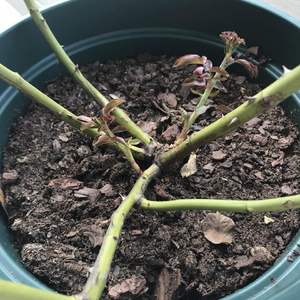
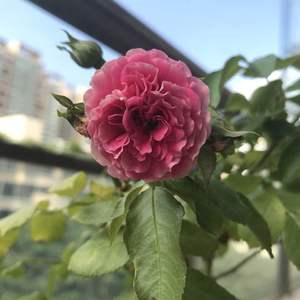

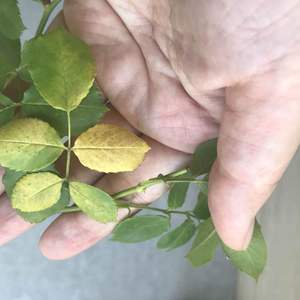




0
0
文章
Miss Chen
2018年06月29日


1.Ice Plants
Ice plants are an interesting genus of succulents, with daisy-like flowers. There is a good amount of variety among ice plants; some are low growing spreaders, others become bushy subshrubs. There are over 150 species in this genus from southern Africa. Most are easy growers that bloom freely. The botanical name, Lampranthus, is from the Greek words "Lampros" (bright) and anthos (flower).
Leaves: The stocky leaves grow in pairs and can be cylindrical or almost triangular. They are short, very succulent and often blue-green.
Flowers: Daisy-like flowers with thin petals that only open in the sun. Different species bloom in vivid shades of yellow, orange, pink and red. The flowers form near the stem tips. Some varieties bloom over a long period, others only a few weeks.
Botanical Name
Lampranthus species and hybrids
Common Names
Ice Plant. You may see individual species labeled as Ice Plants and some have quantifiers like Trailing Ice Plant. It can be confusing. If you are looking for a specific plant, you would be wise to have the botanical name.
Cold Hardiness
Hardiness will vary with the species and variety, but most are only perennial in USDA Hardiness Zones 8 - 10. Some species can tolerate a light frost, but despite their name, prolonged periods of cold, damp conditions will cause them to rot. Gardeners in colder areas can grow them as annuals or houseplants.
Sun Exposure
All varieties of ice plant grow and bloom best in full sun.
Mature Plant Size
The size will vary among the species, but most of the commonly grown ice plant varieties remain 2 ft. (60 cm) tall or lower, with a spreading habit.
Bloom Time
Many ice plants put on their best show in spring, with sporadic repeat blooms throughout the season, however, a few, like Lampranthus spectabilis, bloom all summer.
Suggested Varieties of Ice Plant
Lampranthus aurantiacus - Spring blooming, upright plant with bright orange petals around a yellow center. H 2 ft. (60 cm)
Lampranthus coccineus / Redflush Ice Plant - Bright red flowers throughout the season. Somewhat frost tolerant. H 2 ft. (60 cm)
Lampranthus haworthii - Blue-green leaves held up like a candelabra are covered with pink or purple flowers in the spring. Repeat blooms sporadically. H 2 ft. (60 cm)
Lampranthus spectabilis /Trailing Ice Plant- Long blooming in white or purple-pink. Low growing and spreading. H 2 ft. (60 cm)
Design Suggestions Using Ice Plant
Where the plants are hardy, they make a nice ground cover. Ice plants thrive in poor soil and make a wonderful alpine or rock garden plant or tucked in a stone wall. Their spreading habit means they quickly fill a container and spill over, so they are equally nice in hanging baskets and free-standing containers.

2.Growing and Caring for Ice Plants
Ice Plant Growing Tips
Soil: A neutral soil pH is fine, but it is more important to provide sandy, well-draining soil. Plants will rot if left in wet or damp soil for prolonged periods of time.
Planting: Ice Plants can be grown from either seed or cuttings. Seeds need warm temperatures (55 F.) to germinate. Taking cuttings is the fastest method. Make cuttings while the plant is actively growing, from spring to early fall. Cut shoots about 3 - 6 inches long and remove all but the top set of leaves.
Succulent cuttings should be allowed to dry slightly and callus. Leave them out in the air for several hours or overnight. Then root in sandy soil, in containers. Keep the soil evenly moist, until the cutting root. You can tell they have rooted by gently tugging on them. If they offer resistance, they have rooted and can be potted up.
Caring for Ice Plants
Established plants are extremely drought tolerant, however, they do prefer regular weekly watering during the summer. Allow the soil to dry out between waterings in the winter, when they are somewhat dormant.
Flowering is more abundant if container grown plants are fed a balanced fertilizer, according to label directions. In-ground plants should be fed if the soil is poor or if blooming is sparse.
Plants can be divided or repotted in early spring.
Pests & Problems of Ice Plants
Weather is the biggest problem when growing Ice Plants. Few diseases have been reported, but mealy bug and scale can occasionally infest.
0
0



